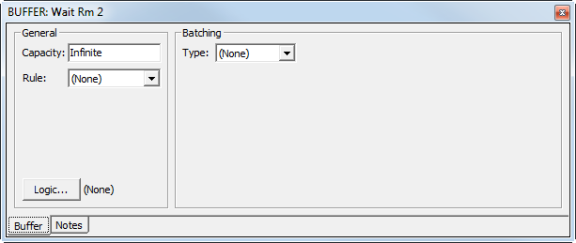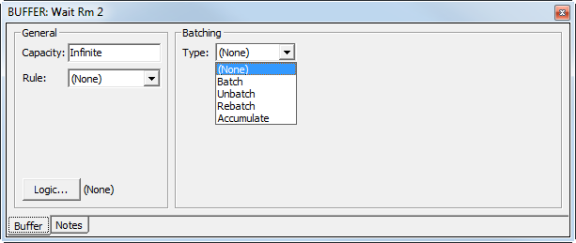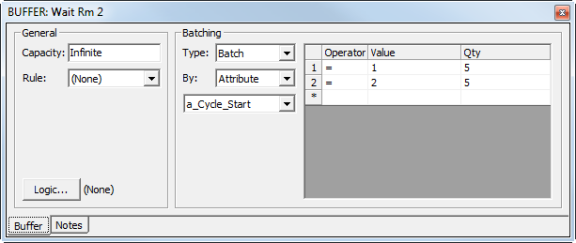Open topic with navigation
Buffer Tab

Buffer Tab: General
- Capacity The
maximum number of entities that can be in the buffer at one time.
- Rule The
way entities are stored in the buffer and subsequently released is controlled
by one of three rules.
- None
Any entity
can leave the buffer in any order. When the rule is set to “None” the
first entity in the buffer will typically be first entity out of the buffer,
but if a SEND command is issued for an entity from a buffer that has a
none rule, any entity requested by the SEND command can be released, and
is not restricted to the typical FIFO behavior.
- FIFO
When the
FIFO rule is selected, the first entity entering the buffer must be the
first entity out. Entities cannot be released from the buffer except
in the order they arrived.
- LIFO
When the LIFO rule is selected, the last entity entering the buffer must be the
first entity out. Entities cannot be released from the buffer except
in the reverse order they arrived.
- By Entity Type
This rule
will cause the entities entering the buffer to queue up in a FIFO rule
by type.
- Logic Opens
the logic builder, which is used for defining the logic to be executed
for each entity upon entering the buffer.
Buffer Tab: Batching

Batching options cause entities to be either grouped into a single entity or ungrouped into multiple entities in the buffer. This determines whether entities route to the next activity individually or as a group.
- Type: Determines
the type of batch in the buffer.
- None
No batching
of entities occurs in the buffer.
- Batch
Entities
entering the buffer are grouped into a batch prior to routing to the next
activity. If this option is selected, a batch size must be entered.
- Unbatch
Entities
entering the buffer as a batch are unbatched prior to routing to the next
activity.
- Rebatch
Batches
or entities entering the input buffer that were previously part of a batch
are rebatched into their original batch size prior to entering the activity.
- Accumulate
The Accumulate
option does not group entities into a batch, but rather holds the entities
in the buffer until the number of entities specified in the Quantity field
are reached. When the quantity is reached, the entities are released.
- Quantity The number
of entities in each batch, or the number of entities to accumulate.
- By Entity Type When this
option is selected, batching and accumulating are done for each entity
type. For example, entity types EntA and EntB both enter a buffer. If "By (None)" is selected, both EntA and EntB can be batched together. If "By Entity Type" is selected, you can choose to batch only EntA
entities together. Choosing <OTHER> will batch or accumulate
all entity types that enter the buffer other than the specified entity types.
- By Attribute When this option is selected, batching and accumulating are done according to the attribute value of each entity entering the activity. Select from the list of attributes which one will be evaluated for batching. In the grid, define the groups to be batched by specifying the value of the attribute and what the batch quantity will be for entities with that attribute value.

© 2015 ProModel Corporation • 556 East Technology Avenue • Orem, UT 84097 • Support: 888-776-6633 • www.promodel.com



